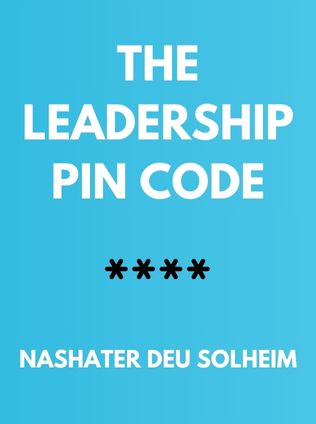
The Leadership PIN Code
Unlocking the Key to Willing and Winning Relationships
By Nashater Deu Solheim
Published 02/2020
About the Author
Dr. Nashater Deu Solheim brings a unique toolkit to leadership development, backed by decades of experience in business and psychology. As a former forensic psychologist with clinical research in neuropsychology, she has developed a deep interest in effective learning strategies for lasting success. Dr. Solheim is also an expert negotiator, having studied at the Program on Negotiation at Harvard Law School. Her career spans roles as an executive leader in international private companies and government ministries. In "The Leadership PIN Code," she combines her diverse expertise to provide a definitive guide for business leaders seeking to secure influence and achieve impactful results.
Main Idea
"The Leadership PIN Code: Unlocking the Key to Willing and Winning Relationships" by Dr. Nashater Deu Solheim is about becoming the most engaged leader possible by examining one's approach, behavior, and conversations with those they lead. The book uses PIN as an acronym for the primary tasks of a leader: to persuade, influence, and negotiate. Solheim emphasizes the importance of emotional intelligence and empathy in building effective leadership relationships.
Table of Contents
- Introduction
- Entitled or Engaged Leader?
- Persuade, Influence, Negotiate = PIN
- Eight Common Dysfunctional Beliefs of Leaders
- PIN and Emotional Intelligence
- A Is for Approach and Advanced Preparation
- B Is for Body Language and Behavior
- C Is for Conversation
- Conclusion
Introduction
Dr. Nashater Deu Solheim begins by differentiating between entitled and engaged leaders. Entitled leaders make changes based on their own power and authority, often disengaging their teams. In contrast, engaged leaders gather as much information as possible, seek input and buy-in, and explain the motives for change. Engaged leaders are curious about their teams and stakeholders, building rapport and alliances to effectively navigate their organizations.
Entitled or Engaged Leader?
Entitled leaders focus on their own power, while engaged leaders prioritize understanding their organization, culture, and people. Engaged leaders seek input and buy-in from their teams, ensuring changes are relevant and necessary. They communicate motives clearly and build alliances, garnering cooperation and collaboration for effective leadership.
"Both the entitled leader and the engaged leader have mandate, authority and power, but they use them differently." – Dr. Nashater Deu Solheim
The distinction between entitled and engaged leaders is crucial. Entitled leaders often make decisions unilaterally, imposing changes without considering the impact on their teams. This approach can lead to disengagement and mistrust among employees. On the other hand, engaged leaders take the time to understand the needs and motivations of their team members. They involve their teams in the decision-making process, fostering a sense of ownership and commitment.
Engaged leaders are also adept at navigating organizational dynamics. They understand the importance of building alliances and leveraging the influence of key stakeholders. This approach not only ensures the successful implementation of changes but also enhances the overall effectiveness of the organization.
For example, an engaged leader facing resistance to a new policy might hold meetings with team members to discuss their concerns and gather feedback. By involving the team in the decision-making process, the leader can identify potential issues and address them proactively, increasing the likelihood of successful implementation.
Persuade, Influence, Negotiate = PIN
The PIN Code represents the keys to creating willing and winning relationships. Persuasion, influence, and negotiation are essential for achieving business goals. Solheim outlines an approach that leverages psychological principles to build effective leadership skills.
"If you’ve ever wondered how a psychologist encourages people to open up and commit to positive change, I’m going to show you how it’s done with three keys." – Dr. Nashater Deu Solheim
Persuasion is about closing the gap between one's position and that of another person. It involves understanding the other person's interests and motivations and finding ways to align them with one's own goals. Effective persuasion requires empathy, active listening, and clear communication.
Sign up for FREE and get access to 1,400+ books summaries.
You May Also Like
The Subtle Art of Not Giving a F*ck
A Counterintuitive Approach to Living a Good Life
By Mark MansonRich Dad Poor Dad
What the Rich Teach Their Kids About Money - That the Poor and Middle Class Do Not!
By Robert T. KiyosakiHow To Win Friends and Influence People
The All-Time Classic Manual Of People Skills
By Dale CarnegieQuiet: The Power of Introverts
The Power of Introverts in a World That Can't Stop Talking
By Susan Cain



















